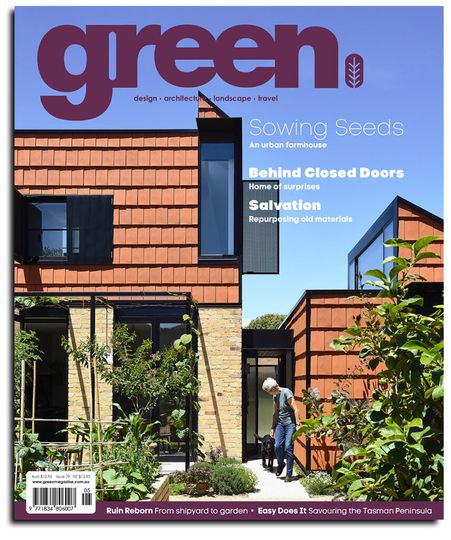Today we chat with Nicola Dovey from Drawing Room Architecture about her alternate route to architecture and why it helps her as a designer, plus a recent project she's proud of and why...
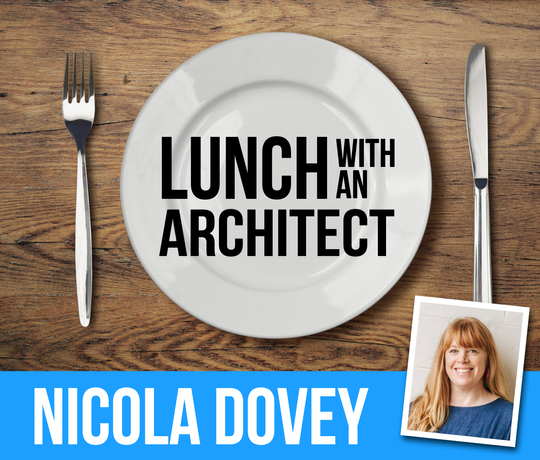
Brodie: As this is (virtually, at least) lunch with an architect, what is your favourite lunch choice?
Nicola: Well, I have to say that it would be being able to go into the city and to have lunch meetings and eat at Cumulus and basically just be based on site and having a really long, relaxed lunch. Just being able to eat lunch with people and all of the places you used to love going to still being open. I feel like something that simple has just... it's become somewhat of a novelty.
What drew you (pardon the pun) to study architecture?
I had a lot of things that I really liked when I was going through school and I had a list of things that I wanted to do. I actually I worked my way through a number of them before I started studying architecture. So, I was at art school first of all, because I loved painting and sculpture. I was there for two years, and I loved all of those subjects I visited the design school at the University and I loved how they worked collaboratively and I really loved how it was more about the environment and structures, not just singular pieces and a single practitioner. So I went to design school and I did work designing exhibition spaces, outdoor spaces, indoor spaces. It was being run by a bunch of architects who were all doing their masters through RMIT. But the focus was very, very broad, it was more concept design. And so I had two years of that and I pulled all those [units] together which amalgamated into a design degree. I got to the end of that and one of my lecturers said to me, 'what are you going to do now,' and I said 'now I think I want to go and study architecture,' and he said, 'well, you might want to travel a bit or go and see a bit more of life before you sit down for another five years in an institution and study'.
So I was doing illustrations and costumes and props and film for theatre and film and got to travel and basically see the city, the suburbs, the buildings. Then I went on to London and had a good look around there. And then went, 'okay, I'm ready. Now I'm ready to start studying architecture.' And so I actually started studying architecture after I had done a bit of travel, a bit of work and study. I was 24 and I was like, 'okay, I'm ready to move to Melbourne.' I didn't even know which school to go through, I didn't know the difference between RMIT versus Melbourne Uni. Kind of worked it out along the way and ended up at Melbourne Uni. So yeah, it was a bit of a journey.
I love a bit of an alternate route. There's so much more to learn out there. Drawing on lots of different experience can be really helpful for an architect.
It helps because architecture is such a huge, huge subject. It's designing a building that someone wants to live in. It's quite clear if you've been to a few different countries and looked at a few different buildings, that, okay, there are quite a few different ways this could go. It's a pretty demanding area, so it's not bad having a bit of experience before you face all that.
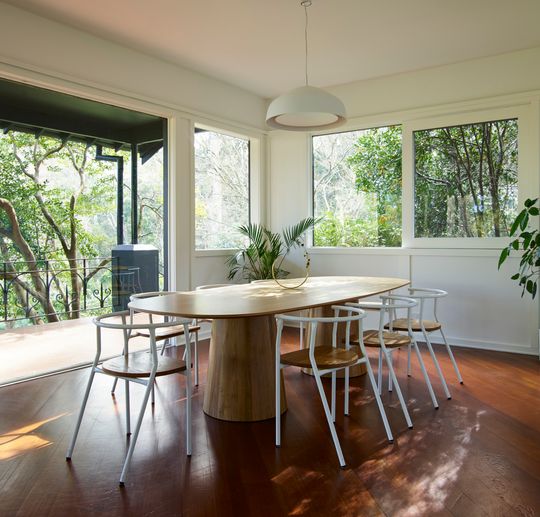
Selby Aura Family Home by Drawing Room Architecture
So what's your favourite thing about residential architecture?
When I left university, I went to a very big firm and there's obviously a large team working for a long time on quite a big, complex buildings. I then moved to a smaller firm and worked on smaller buildings. And then just before starting out on my own went to a very small company and I think one thing that residential architecture is really good for is, as an architect, getting to experience all parts of the project. So you're working with a client initially to work out how they live, what they're looking for, what kind of building you might be starting with, or what kind of building you might be creating, and then you work with the council, draw it all up, keep working with the client to make sense of it and then you start working with a builder right the way through the build until you can walk away, it's complete and they can walk into it. So you really get to have quite a broad understanding of what kind of issues are going to come up and how you might go about resolving them. And also, you can know who your client is and who you're designing for. You're designing for these people standing in front of you. So it's quite satisfying, in that way, because in the end, they can tell you how it does work and how they do use it. They're using it every day, so you get some feedback and they say things like, 'this is what we like the most,' or 'this is what we do and this is what's worked the best.' So you're very involved with lots of people during the process and you get to know the people who are going to live in it.
That's very true and it's very personal feedback because, as you said, they're living in it every day. So the information that you're getting back is very specific about what works and what doesn't work.
That's right. And so in the initial meetings with people, every question's on the table, like, how do you do this, and what's important to you about this, and also I make sure that we are quite closely aligned with what we're being asked to do. So for example, do I get this? Are we aligned? Because what you're creating is every room that people will live in, it's where they'll do their laundry, where they'll put their toothbrush. You want to make sure you're on the right page from the beginning.
What's the biggest challenge when it comes to residential architecture, then?
There are many challenges, but often people have a very clear idea of what they want themselves. You hoping you can work through all the things that the client wants, but you're also trying to clients take them in a slightly different direction from what they might be saying that they're after, to also put something in front of them to suggest what's possible. So you have to walk a fine line between understanding exactly what they want and offering new opportunities. On one hand, you're trying to meet the amenity: they want two bathrooms and two living areas and that's all possible, but you can also see there are views or there are opportunities of getting light into certain areas of the house. So, in fact, you are giving them the amenity, but you're also offering this other kind of opportunity or experience. So you can say, 'yes, we have all of those rooms, tick, tick, tick, but also, look at the way the light comes right into your living areas through the day.' It can be hard to explain that's what we're trying to do, but when they're in that space, they have a really good experience. And usually, it's when they walk around they say, 'Oh, wow, that view is amazing.' Or, 'I love the way the light comes down there.' Or, 'I enjoy walking through the hallway now, because I walk into a pool of light.' That's the challenge, we're trying to bring in a beauty and an experience which are hard things to describe until you actually are on the site and until you are experiencing it.
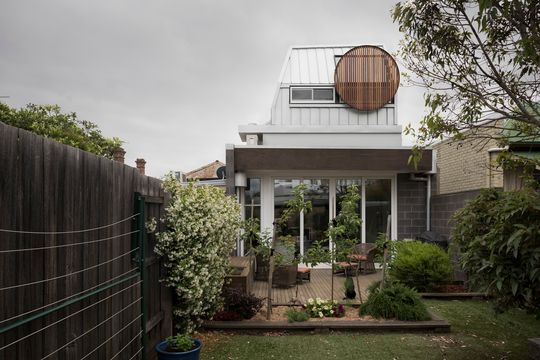
Wilson Street House by Drawing Room Architecture
Now, for something a bit different, what's your very mild superpower?
A superpower is something that helps you out in a sticky situation, so I have to say that my very mild superpower is my sense of humour. It's helped me in the past in tricky situations.
So what about the first album you ever bought?
This isn't actually the first album that I bought, but my first memory of an album... When I was turning seven, my mother bought a record. It was probably more for the house, but because it was my birthday and she put the record on, I believe that actually, it must be mine. She bought Thriller. We played and I think every different song was better than the one before. I think that's the only birthday I remember from my childhood because we danced to Michael Jackson for what felt like hours to me. So thanks, Mum!

What's a project of yours that you're most proud of and why?
Actually, I think Brunswick Green is one that I'm currently most satisfied with because it was a compact site, it had a heritage overlay, I think it was barely 300 square meters, it was built to the boundary on both sides. What we were working with, the existing building, was very old, everything was kind of wonky, but they wanted lots of light and we kind of had to build to the boundary on both sides and not a lot of light was available. So it was nice to walk through and see that in fact, there is daylight coming into all of the rooms. The clients also wanted to be able to capture all of their rainwater. But it was quite a tight site so a lot of services had to run in very narrow spaces. Luckily not aware of any of that now that the building's finished. There are solar panels and we had the gas connection cut, so we were working through hydronic heating, where can we put that kind of infrastructure. And we wanted it to be really cozy in winter so we used slightly more installation than we needed to. It's one of the projects that I am really happy about how it performs and how comfortable it is. It's getting so much daylight, natural ventilation, staying warm, staying cool passively. It obviously does have mechanical heating, but they don't have to use it anywhere near as much as they had to in the past. And it's just a beautiful, compact home. I love visiting it and I like to hear about it, it's been very satisfying.
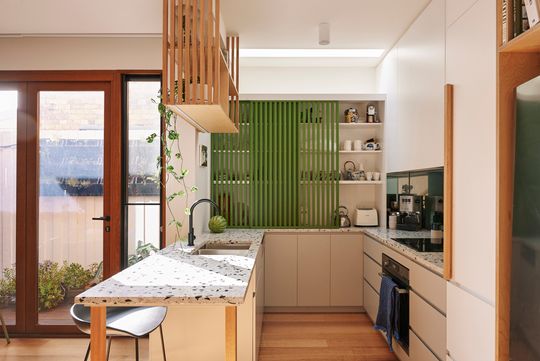
If you were hosting the ultimate dinner party, which four people would you invite and why?
Okay, I've got Bob Brown who's very sustainably aware, but also very aware of politics as well as the environmental aspects and how those two aspects sit together. Michelle Obama because she has a mind for politics but also social justice. She understands the workings behind what we see on TV or in the newspaper. It would actually be quite interesting to see behind the scenes. I'm trying to think of a musician, I'm going to go with Liz Stringer because as a musician, you're thinking about the ephemeral and you're thinking about the universal, but you also live in society, so there's something kind of wild about a person that's able to do that. I need a fourth person, I think it might be Bjarke Ingels. He's still a pretty young guy, imagine the process he would have gone through within 20 years to be at the top of the ladder and run an architecture practice that takes on projects all over the world. That is a pretty extraordinary achievement, I think he would have great stories.
What's your favourite season and why?
Ah, spring. Spring's got the excitement, it's opening up after a long, dark winter. So the sun starts coming up earlier in the morning and you're getting close to the end of the year. And everything that any kind of underground waiting comes to life. Spring's dynamic, and that has to be my favourite season.
Do you prefer working on new homes or renovations?
To a certain extent with renovations, you've got a place to start. With a new build you clear the slate, it's completely wide open, so it's a bit terrifying. But you get to put the rooms in the right place and the challenge is to make it really good not to make sense of things that are already there. So definitely new build. With renovations, it's like the sentence has already been started and so everything you do is in relation to something which already exists. Whereas if it's a new build, you just kind of make up that whole language from the start.
What's something about architects you wish more of the general public knew?
Most architects that I know are grounded, creative, very hard working, caring, environmentally aware people who are working hard to try and bring a whole lot of disparate elements together in a really satisfying way. I think that you do work very hard to actually be an architect in countries like Australia and New Zealand. Obviously, there are lots of benefits: we've got a lot of space and we also have a lot of makers, but there's not an expectation that 'I will use an architect.' So we have a fair amount of education to do on every project, and on every phone call, whenever someone rings me, they've been told they need an architect, but they don't really know why. It's not like they know ten architects and they called the one they know, to be the best. So a lot of it is talking them through what an architect can offer. I feel like it's very easy for there to be a misunderstanding as to what it is architects and why you would want to work with one. Even if people could understand what we do would be great! Lots of people don't know what this process is and it's a big process. It's a long process. So any way of being able to share and help people understand what to ask for, what to expect, is still very important.
What resource would you recommend to someone wanting to build or renovate?
The resources that I suggest and use are magazines, predominantly Green magazine, or Sanctuary magazine, or Houses magazine, but also, I think, there are (plug!) a number of online resources, which are going to put ideas in front of people. When you're able to read through a bunch more information about what the process was like, what some of the challenges were, questions to ask are, or, what some of the priorities could be, you get a better understanding of the process and not just the beautiful images.
